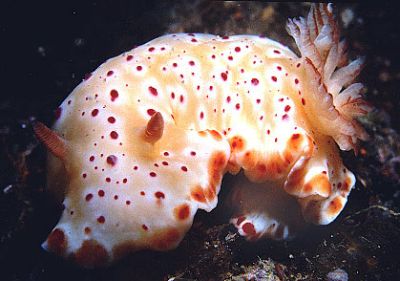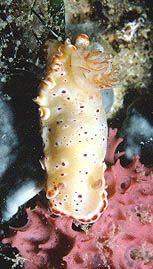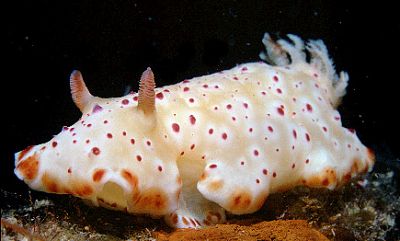

Chromodoris cf. tasmaniensis
Order: NUDIBRANCHIA
Suborder: DORIDINA
Superfamily: EUDORIDOIDEA
Family: Chromodorididae
PHOTO
Rapid Bay Jetty, South Australia.
Upper Photo: Depth 9.5m, 4cm in length. 18 February, 2001. Lower Photo: Animal feeding on a red aplysillid sponge on a jetty pylon at a depth of 5m, 3.5cm in length. 26 March 1998. PHOTOS: John Chuk.
This species has similarities in colour to Chromodoris tasmaniensis but I very much doubt if they are closely related. As I discuss on the C. tasmaniensis Page, and elsewhere, there are many species of chromodorid in south-eastern Australia with a colour pattern consisting primarily of a white background and red spots. I have suggested that this concentration of similarly coloured, but unrelated species, is an example of mimicry. Of particular interest is the way that species with a wide geographical distribution in southeastern Australia change details of their colour pattern to match the slightly different patterns in subregions of southeastern Australia. For example C. tasmaniensis in New South Wales has large, similar sized red or orange spots scattered over its mantle to match the common colour pattern in this area. In the Bass Strait region further south, the common colour pattern differs in having a submarginal band of smaller spots around the mantle edge. C. tasmaniensis in Bass Strait differs from New South Wales animals in having small spots around the margin as well.
This animal fits the prevailing colour pattern in southern waters very well. It also feeds on one of the pink species of Darwinella which so many of these red-spotted species eat.
References:
•Rudman, W.B. (1983 ) The Chromodorididae (Opisthobranchia: Mollusca) of the Indo-West Pacific: Chromodoris splendida, C. aspersa and Hypselodoris placida colour groups. Zoological Journal of the Linnean Society, 78: 105-173.
•Rudman, W.B. (1987a) The Chromodorididae (Opisthobranchia: Mollusca) of the Indo-West Pacific: Chromodoris epicuria, C. aureopurpurea, C. annulata, C. coi and Risbecia tryoni colour groups. Zoological Journal of the Linnean Society, 90: 305-407.
•Rudman, W.B. (1991) Purpose in Pattern: the evolution of colour in chromodorid nudibranchs. Journal of Molluscan Studies, 57, (T.E. Thompson Memorial Issue): 5-21.
See John Chuk's message.
Authorship detailsRudman, W.B., 2001 (May 21) Chromodoris cf. tasmaniensis [In] Sea Slug Forum. Australian Museum, Sydney. Available from http://www.seaslugforum.net/find/chrocftasm
Related messages
Chromodoris cf. tasmaniensis from South Australia
May 25, 2001
From: John Chuk

Dear Bill,
Here are some photos of a chromodorid that I'm unable to identify. The photos are of specimens found on two occasions at Rapid Bay Jetty, South Australia.
The lower left photo is an in situ shot taken on 26 March 1998 of a specimen found feeding on a red aplysillid sponge on a jetty pylon at a depth of 5m. The specimen was 3.5cm in length. The two large photos are in situ shots taken on 18/2/01 of a specimen found crawling over the bottom at a depth of 9.5m. It was 4cm long.
Both specimens have a creamy-yellow notum which is covered with small raised red spots with pale areolae surrounding them. There is a broken orange submarginal band. A similar band was observed on the foot. The red spots on the notum extend into the submarginal orange band. The rhinophores are lamellate and are tinged orange. The gills are white except for their inner edges which are orange. These shots show the broken orange marginal band on the foot and the raised nature of the red spots on the notum. There is a piece missing from the mantle margin. The first specimen I met back in 1998 also had damage to the mantle. I hope these shots are of some use!
Any help in identification would be appreciated. Once again I thank you for your past help and for all the effort you put into the Forum. It has proved a most useful site!
Best Wishes,
John.
jchuk@giant.net.au


Dear John,
This is a very interesting find. I spent a number of years accumulating information on red-spotted chromodorids in south-eastern Australia trying to sort out their relationships and colour variations [see references at top of page]. I have never seen this colour pattern before.
It has similarities in colour to Chromodoris tasmaniensis but I very much doubt if they are closely related. As I discuss on the C. tasmaniensis Page, and elsewhere, there are many species of chromodorid in south-eastern Australia with a colour pattern consisting primarily of a white background and red spots. I have suggested that this concentration of similarly coloured, but unrelated species, is an example of mimicry. Of particular interest is the way that species with a wide geographical distribution in southeastern Australia change details of their colour pattern to match the slightly different patterns in subregions of southeastern Australia. For example C. tasmaniensis in New South Wales has large, similar sized red or orange spots scattered over its mantle to match the common colour pattern in this area. In the Bass Strait region further south the common colour pattern differs in having a submarginal band of smaller spots around the mantle edge. C. tasmaniensis in Bass Strait differs from New South Wales animals in having small spots around the margin as well.
Your animal fits the prevailing colour pattern in southern waters very well. It also feeds on one of the pink species of Darwinella which so many of these red-spotted species eat. It is indeed an interesting find. I am glad you find the Forum useful. I can say that finds like this make the time I spend on it well worth the effort.
Best wishes,
Bill Rudman
